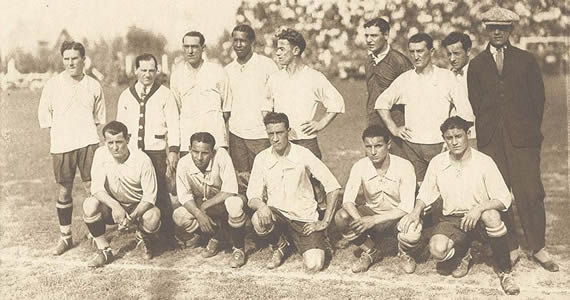El Bolso is back with his second installment of the History of Club Nacional de Fútbol series.
Hello again! Last time, we saw Nacional providing players for the Uruguayan national team when no one else would and winning a championship a year late, despite an ongoing civil war, political persecution of players and the shenanigans perpetrated by the national association, which was biased in favor of teams under foreign control. The next decade was marked by tragedy and mediocrity, but eventually Nacional would regain its swagger. It would take an infusion of talent from Uruguay’s lower classes, mixing with the team’s original base of university students, to put them back on top.
Too Sexy (for the Uruguayan league)

After the 1903 championship (which, as you know by now, was decided well into 1904), Nacional experienced an identity crisis. In 1905, a smallpox epidemic ravaged the country, killing Carlos and Bolívar Céspedes, two of the team’s founding members and cornerstones of their early success. At the same time, the club was in the middle of an institutional struggle, with one faction trying to keep it focused on its upper class, college-educated roots, and another working to make it more inclusive. In 1911, the conflict came to a head, with the populists winning control, and many traditionalists heading over to Bristol FC. The new Nacional incorporated several players from the lower class, including Abdón Porte, a stalwart defender who would become a symbol of the club’s new identity.
The change yielded immediate results: Nacional won the 1912 championship, ending a nine year drought, and between 1915 and 1924, it finished first 8 years out of 10. By this time, however, Uruguayan soccer was in crisis. In 1922 Peñarol, which had replaced CURCC as Nacional’s main rival (more on that in a future post), played a friendly against Racing of Argentina. Unfortunately, Racing had recently supported a rebellion against the established Argentinian federation, helping to form a rival league. Acting in solidarity with their Argentine colleagues, the Uruguayan association promptly threw Peñarol out of the league, leading to a similar split in Uruguay between the existing AUF and the new, Peñarol-backed FUF (really, it’s more fun if you don’t know what the acronyms stand for). Over the next couple of years, the two leagues held simultaneous tournaments and competed with each other for official affiliation with FIFA. The AUF won that battle, which allowed it to send a team to the 1924 Olympics. At that point, the government decided to tell all parties involved to cut it out and act their age, leading to a reunification plan that included having no tournament at all in 1925 (there was a lot of stuff to work out). Having provided the backbone of the newly crowned Olympic champions, Nacional took advantage of the long vacation to plan what has to be the longest barnstorming trip in the history of soccer.
Fantastic Voyage (Slippity Slide)

Banking on the success of the national team the previous year, Nacional left for Europe in early February, taking its main squad along with some additional players that would eventually sign with the club, like Jose Nasazzi, captain during both Olympic runs and the first World Cup win. It was basically the same team that had just won the gold: four of five starting forwards (they played with a lot of forwards back then) were the same. Still, not much was expected of them, certainly not by European fans.
This was not one of those fancy trips like the Dream Team takes these days, with private planes and separate hotels, and royal tasters or whatever perks LeBron and company get. They crossed the Atlantic on a commercial passenger ship, because that’s what you did back then. You spent several weeks at sea, hoping you weren’t predisposed to seasickness. In fact, the length of the trip would be used as an excuse years later when many European powers declined invitations to the inaugural World Cup.
Nacional played their first game on March 7 and their last on August 8, returning home on August 30. That’s right: they were on the road for seven months if you count travel time. Remember that when Gregg Popovich complains about having to play four times in five nights. All told, the team played 38 games in 9 countries (including several against national teams), winning 26, tying 7, and losing only 5. They scored 130 goals and gave up 30. The top scorers were Héctor Scarone with 26 (that’s right, 4 less than all their opponents combined), and Héctor Castro, nicknamed “el Manco” because he had been born without a hand, with 19 goals. Seven different players scored 10 or more goals. They beat the Netherlands national team 6-0; they split a pair of games with Belgium, winning 5-1 and losing 1-2; and they played France twice, tying 0-0 and winning 6-0. Their biggest win was 13-1 against Manacor, a club team from Mallorca, and they scored 5 or more goals 13 different times. So yes, they were kind of a big deal.
Uruguayos Campeones

While Nacional was dominating local competition, the national team was also busy making history. During the 1920s Uruguay established itself as the best soccer-playing nation in the world. After the end of World War I, soccer’s governing body, FIFA, made its push to make the sport a global phenomenon: first it lobbied for a more inclusive Olympic soccer tournament, resulting in the admission of teams from outside Europe. In 1912, 11 nations — all European states— fielded teams. In 1920, (the 1916 Olympics were cancelled because of the war), 20 teams were present, including the first non-European squad: Egypt. Four years later in the French town of Colombes, there were single teams from Africa, Asia, North America, and South America. By the time Amsterdam hosted the games in 1928, they were letting anyone in (e.g., Argentina).
Having obtained FIFA membership in 1923, Uruguay was eager to show what it could do in the international arena, so the AUF signed up for the 1924 Olympic tournament (that’s all you had to do back then). The President of the association at the time was Atilio Narancio, one of Nacional’s founders, and the driving force behind the effort to send the team to France. Prior to the 1923 South American championship, he told the team that if they won the title, he would take them to the Olympics; they did, and he did, mortgaging his own house to pay for the cost of the trip (which was by boat, of course) when the government failed to step up. Uruguay took Colombes by storm, beating Switzerland 3-0 in the gold medal game to cap a five-match run in which it outscored its opponents 20-2. Nacional provided four of the players in that final game; six of the other seven would end up wearing the red, white, and blue soon enough.
Uruguay would defend its Olympic title in Amsterdam 4 years later, beating Argentina 2-1 in a shocking final matchup. FIFA then decided it was popular enough to stop piggybacking on the Olympics, organizing the first World Cup in 1930. Uruguay, as two-time defending champion, won the right to host it over Italy, which royally pissed off some guy named Benito something-or-other. The team then capped off their magical run by winning the tournament, again besting Argentina in the final (get used to that). Nacional had helped make Uruguay the best team in the world.
- The Charrúa Report: On the Right Foot - March 14, 2017
- The Charrúa Report: Campeones! - February 14, 2017
- The Charrúa Report: 48 Is Enough - January 11, 2017
- The Charrúa Report: Nico and the Sounders - December 14, 2016
- The Charrúa Report: King of the Single Rounders - December 12, 2016
- The Charrúa Report: Senseless - December 6, 2016
- The Charrúa Report: The Bum’s Rush - November 28, 2016
- The Charrúa Report: A Bump in the Road - November 16, 2016
- The Charrúa Report: Is It Priceline Time? - November 12, 2016
- The Charrúa Report: Closer to Fine - October 13, 2016


One thought on “Nacional: The Roaring Twenties”
Comments are closed.